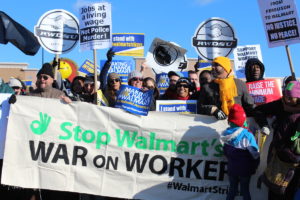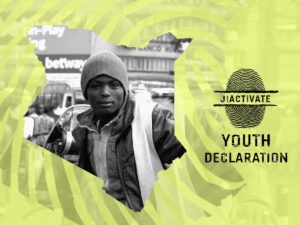
#CharitySoWhite only began around 9 months ago and has unmistakably started a long overdue reckoning around racism in the “professional do-gooder” sector. A UK-based collective of 15 organising members who all have different day jobs and identify as people of colour, they are committed to organising to reframe the narrative of racism, power and privilege in non-profit and charity organisations and foundations.
Their brilliant humour on social media, sobering research on the disproportionate impact of the coronavirus on BAME communities in the UK, and young coordinating members who identify as people of colour are part of the many reasons for their success. We were honoured to interview two of their organisers, Rini Jones and Jonathan Cornejo. We are publishing this interview in two parts, and here is part one:
AH: So first, I wanted to ask about the relationships that people have on the organising committee to each other – I think the website says that you’re about 10 people now.
JC: I think we’re about 15 people now –
AH: What’s the relationship with these people from very different organisations and then coming together?
JC: So, there was a different group called POC Impact that was kind of just a network for people of colour within the charity sector and share experiences and socialise a bit more. Within that conversation and that context, a lot of people saw a problem with all of this, a lot of us shared experiences of microaggressions within their organisation, and then when the story broke with Citizens Advice, when they had this training session on working with BAME communities, it was just full of stereotypes and full of problematic things. #CharitySoWhite really emerged because of that, Fatima responding on Twitter and calling it out…. It has kind of evolved where like, we have been responding to things like this for a lot of time. And as we were growing, there was a need for the organising committee to have more people on board and more capacity, and that’s where I came in, where most people came in, in terms of growing in size. Recently, we had another new intake of committee members in, I think, April? We’re a very flat structure and it’s a very open process of ensuring fit with the organisation. It’s very discussive, we do everything through committee meetings.
AH: Has the recruiting been quite organic? Since #CharitySoWhite responds to specific incidents, have people joined through these public moments, maybe out of a perceived necessity?
RJ: Just to frame it from my point of view coming in a little bit later – when it really started from a tweet blowing up – I think it was August of last year? A lot of my peers, a lot of really young people of colour within these organisations, it really resonated with us. Following that activity and seeing how reactive #CharitySoWhite was to really pressing issues, was really inspiring. I wrote a piece, and then I reached out, saying, “If you’d like an extra pair of hands, I’d really like to help.” And it kind of went from there and it did feel very organic. To echo what Jon said, it’s a very flat structure and everyone kind of cheers everyone else on. It’s so warming. And one of the things that I noticed. I was on one of our calls this week, and then I jumped on another call right after, and it was mostly white people. And I noticed that there was a real shift in tone, and it really highlighted that that was really lacking in our sector.
AH: I’m curious about some of [your] advocacy – some of it seems like quite general or introductory to me? You really focus on discussion, open honest discussion. There are these three core principles, right. And then, specifically talking about leadership, do you advocate for an approach that tackles leadership, like, is there some sort of organisational blueprint that you advocate for, or is the campaign really more the beginning around a sector-wide conversation and self-reflection period.
JC: I think where we’re at now is very much about starting a conversation in the sector and changing the frame of the conversation. I find that a lot of the 1-to-1s that we’re in, the conversations that we’re in – I think the expectations from a lot of the white people in the sector are saying that ‘Oh, we’re doing all of this stuff, we’re bringing a lot of brown folks into the conversation’, and they want some kind of praise, they want to keep that kind of level and think it’s enough. I think our ‘blueprint’ in a way is to come into the room and sweep all of that away. We’re not interested in your data, in your four more brown people in the organisation. We wanna shift the conversation to the structures of oppression – white saviour complexes and the way that colonial power structures reflect in our organisations. It takes us to a much more uncomfortable place… We’re very much trying to start those more in-depth conversations across these organisations and across the sector, rather than having a particular, say, you have to do these 5 steps for your organisation to become anti-racist organisation!
RJ: There’s not a step by step plan for assuaging any kind of white guilt. Any kind of messaging around EDI and diversity and inclusion will invariably prompt a lot of eye rolling from us. The position that #CharitySoWhite takes, and what really attracted me and a lot of other people, was a shift from that to a conversation about power and privilege. Because conversations about EDI – if you’re not taking a specific anti-oppression lens, then you’re just bringing people of colour into an unsafe working environment. We all have experiences like that. I don’t think a blueprint like that… and I can’t even imagine what an organisational blueprint like that would look like.
JC: And kind of on the advocacy approaches at the moment – We’re kind of in a flux right now. Because we’re so young, a lot of our advocacy is with organisations that already know us… We are still trying to get to a place where we can sit down and have a think more about strategy, have a think more about who are the key players in the sector, what kind of impact can we have if we go off with this person… For the moment, we are very focused on the key people who we’re engaged with and who are coming to us, and that comes from building up our sort of brand and overall awareness of our kind of sector.
AH: I’m interested in these different lenses of power – I think it’s really interesting to focus on reframing racism and reframing the conversation from diversity and inclusion to power and privilege. So then what’s the campaign lens globally then? So in terms of power and privilege across the entire sector, is there a position or a reflection on the disproportionate power and privilege that these organisations have in other countries?
JC: It’s something that we’re quite cautious about because there’s a lot of [other] conversations about this happening at the same time. But I think that having started working in the UK – all of these issues are really prominent – our approach to that more global conversation is ‘where did all these organisations come from.’ Many of them started in the UK and from a colonial tradition of white saviours going to other countries. So many of these organisations are rooted in that directional relationship. Reflecting on how these layers of colonialism and racism are deeply enshrined in these organisations – how that impacts recruiting people – that’s the conversation and the way we’re trying to take it.
RJ: I think a lot of the campaign power is holding the UK charity sector to account. It’s been really spotlit recently – now more than ever – that the UK is twee, polite, “we’re not racist here anymore, we helped abolish these practices”. It’s been a rude awakening for a lot of people, not for us, that actually the UK is very complicit, the practices are violent – a lot of the practices that we see globally. Having a conversation in the UK charity sector is really powerful because they’re responsible for a lot of these ills.
JC: There’s still a lot of racism in our organisations. The power relationships are deeply complicated, so I’m hoping that this is a real reckoning.
AH: Has anybody from the organising committee experienced any backlash to their work?
JC: I don’t know if there’s been any serious backlash, but I guess we always try to be aware. If we’re working, and an organisation that we work with crops up, then we try to be sensitive about it. My employer has been really sensitive – I work at Save The Children – and I can dedicate a day of my workweek to this. Not all of us have this same level of support, and sometimes it comes down to if we’re speaking publicly. But there hasn’t been any bad cases as far as I know.
RJ: I’d echo that, I don’t know of any backlash. Just speaking personally, I’ve heard of jitters in my own circle. A lot of this work throws up defenses, in terms of the audiences that we’re speaking to. Luckily, I’m also in a fortunate position, where I keep the two areas of work discrete in my life – and my manager is very supportive.
JC: I think what we do get is those more general criticisms about our work, and that’s from all over in the sector – like, oh why are we talking about racism when we should be talking about other things. It’s that kind of critique that we face quite frequently.
AH: I’m curious about the enormous white paper that you did on the disproportionate impact of the coronavirus on the BAME (Black, Asian, minority, ethnic) community in the UK – oh I actually don’t know to pronounce the acronym! Do you spell it out or just say it?
JC: Um, actually both? And just to go on the terminology – we’ve been having a lot of discussions around this. The problem is that BAME is so UK specific and people of colour being from the US – it’s not that these terms are bad on their own… it can be quite useful and for solidarity. It’s good for solidarity but it’s [problematic] when white people and institutions start to talk about these identities and lump all of them together. I’m a Latino, for example, that’s my identity. If we’re going to talk about specific identities, then we should talk about specific identities. If we’re talking about Black women, we should be talking about Black women. That’s very much a live conversation right now.
AH: I have seen the conversation and I don’t know enough to weigh in – I know that it’s a very UK specific lens. I know that BAME is the term that #CharitySoWhite is using, and positioning and sharing that lens in your research. So how has the campaign been for people and organisations to recognise the disproportionate impact that the coronavirus has had on the BAME community in the UK? How has the process of the white paper been?
JC: I guess the term itself is an interesting point to start with. Because when we started off, and in more general conversations, we still talk about ‘people of colour’ and we tend to use that term more often. But when we started to work on specific work of COVID-19 on communities, and outside of the charity sector, we found that we needed to to adapt to use the BAME term because that’s what the government was using, that’s what different organisations were using. It was a very deliberate choice and we wrote about that in one part of the paper… It’s interesting that you have to adopt the frame of wider society in that space, and even us, as a more radical organisation, we have to move in that direction.
In terms of the paper, it started off like – in the beginning of the year, we were trying to think long term and think about strategy, develop some long term strategy for 2020. More and more of our conversations began to draw towards COVID-19 as it started to spread. We all started thinking about how the BAME community and different communities across the UK could be impacted by this thing, that’s where the paper came from… I think the decision to keep it as a live paper for so long, we’ve only just finished it, was because it’s a rapidly developing situation. There was a whole load of different conversations… But we’ve stopped it now because… it isn’t that there isn’t enough data, or that we’re going to hit this point where we’re going to have all the data we need and suddenly policymakers charity and non-profit organisations start doing the right thing. Data is being used as a way to delay the conversation further. To say, “oh we need to understand this better”. When there’s history and years of work for you to draw on to start doing the work. Black Lives Matter sort of, again, sparked that moment where, it isn’t that we’re not giving enough data, it’s that they just don’t care on some level.
RJ: Just circling back to terminology, I think one of the few benefits of using BAME as a term is that it shows the breadth of oppression. Across all of these communities, we have this one thing in common, and it affects each community very very differently, and certain communities face it much more acutely and much more extremely, but we have this one common thread, and that solidarity piece is very important. We’re never going to say non-White people because that centres White people… The paper itself, having all of the data in one place, from all of these areas… it’s a very powerful piece of work. In the beginning, the media narrative was saying that the coronavirus doesn’t discriminate, is a social equaliser, even the Prime Minister can get COVID-19. We live in a country where the institutions that have been built to, essentially protect us, are institutionally racist themselves. The response that our communities receive will be prejudiced, and it’s not going to compare to the experience that white peers will receive. You throw a deadly pandemic into the mix, and it’s a tinderbox. The paper really demonstrates, blow by blow, how deeply entrenched these inequalities have been, and how a virus exposed this very quickly to people who weren’t already aware of it.
JC: It’s been the response to the paper by the charity sector that’s been really interesting. So much of these studies in the news, they show very particular aspects, but when you have it all in one place, some people are finally seeing all of the breadth of this. It’s been interesting to see when you put everything on the table, and you talk about it in a really intersectional space, then the response has to be different. The usual ‘oh, we will just put more money here, or we will do this’ doesn’t really fly.
Stay tuned for part two of the interview, coming next week.




